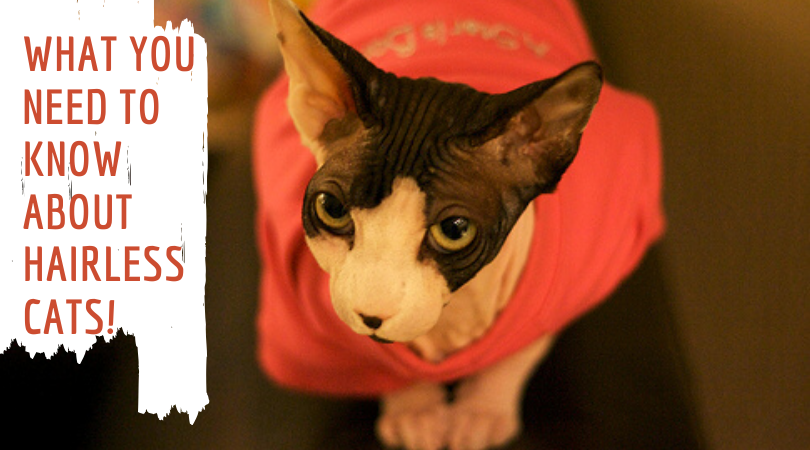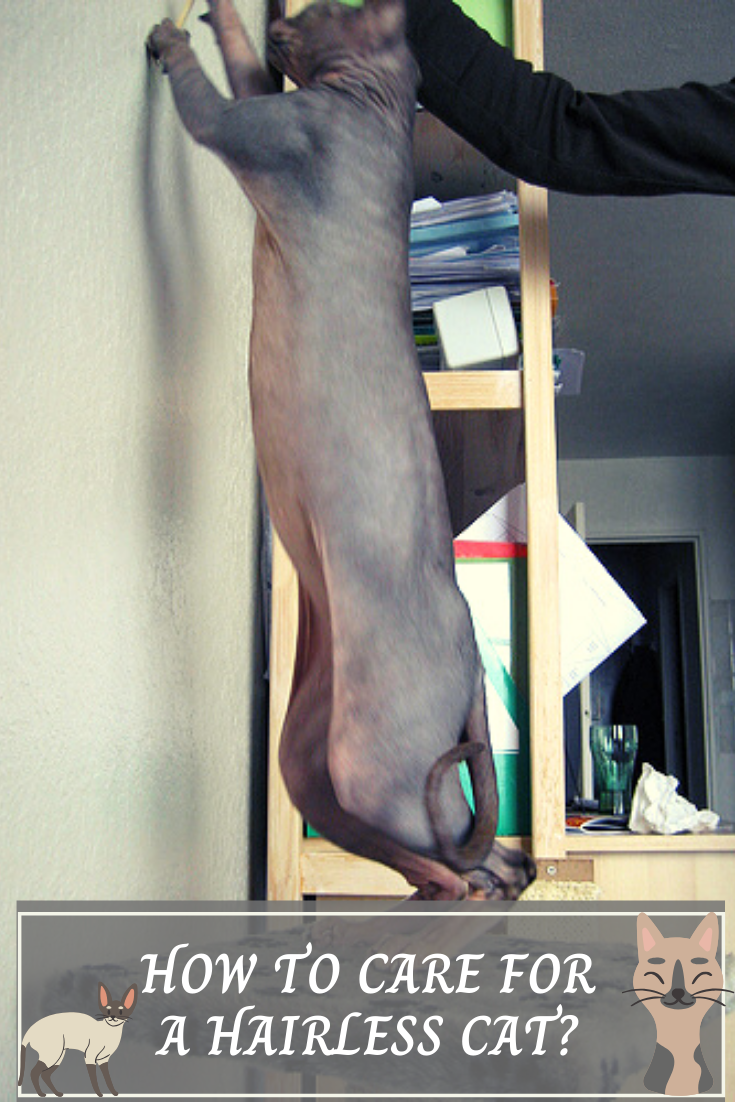Why be a “Me too” and get a cat that looks like the cat everyone else has?
Hairless Cats tend to be friendly, playful, and sociable. They love to snuggle more often because they get cold easier than other cats. This tends to create a closer bond between the lucky owner and kitty. They enjoy crawling under the warm covers to sleep with Mom and Dad.

Post Navigation
Main Hairless Cats Breeds:
- Sphynx Cat
- Bambino Cat
- Peterbald Cats
- Ukrainian Levkoy
- Donskoy Cat
- Kohana Cat
- Dwelf Cat
What Do Hairless Cats Look and Feel Like?
The head of Hairless Cats tend to be wedge-shaped, and their skin is wrinkly in a cute Yoda-like fashion. They tend to have large, adorable ears and a thin tail. Eyes vary from roundish to almond shaped. Their skin is wrinkly and somewhat elastic. It feels soft – like a warm, fuzzy peach or a hot water bottle.
They don’t need to be brushed as often. If they are truly bald, they don’t have to be brushed at all. Shedding won’t get all over your clothes and you won’t have to clean up hair balls.
They look really cool and unusual.
How Big is a Hairless Cat?
Hairless Cats can be anywhere from slim and elegant like a Siamese cat to fairly stocky. They are small to medium sized with an average weight between seven and fifteen pounds. As with other breeds, females are notably smaller than males.
Grooming Hairless Cat
Grooming has to do with how often you have to bathe your cat, clean cats ears, wipe their eyes, clean out their ears, and clean their nails (claws).
If you strongly object to bathing your cat once a week, then Hairless Cats are a less than ideal choice for you. Remember, you’ll have to do that each and every week for several years.
It may not be as bad as you think. Some of my cats actually like the water. For us, it’s a bonding experience. We all have a good time. Not all my cats like the baths though. Some get upset. It’s best to start them bathing a few days after you get them home.
The good thing about Hairless Cats is that breeders usually start giving them baths before you even adopt them. These cats are already used to it.
Grooming also has to do with brushing them. One of the benefits of being a Hairless Cat owner is that you don’t have to deal with brushing them, getting cat hair on your furniture and clothes, or with them getting hair balls. So, bathing them weekly is something of a trade off.
Bathing A Hairless Cat
Hairless Cats do take some extra care. They have little to no hair (hair would normally absorb and disperse oil) and their skin tends to get oily after a while. They need to be bathed once a week.
You can tell when they need it because they start to give off an odor. The smell of the odor varies from cat to cat and from breed to breed. Sometimes it can smell like raw mushrooms or like cheese. When you pet them they leave an oily residue on your hand. You don’t want this on your clothing or furniture.
When bathing your cat, three things should be on hand:
- Cat shampoo (the one that many vets use)
- A clean, dry towel (organic cotton – set of two).
- A large plastic drinking glass or small plastic bucket (to rinse kitty off)
You can bathe your cat in either the sink or in the bathtub. Some prefer the sink because it’s higher and easier to wash the cat.
Cleaning Cats Ears
Hairless Cats need to have their ears cleaned because they have very little hair or none at all in their ears. As a result, wax has a tendency to build up in their ears and it needs to be cleaned out.
We check our cat’s ears once a week. You’ll be able to tell if there’s any wax build up. See the note below the Steps section.
Safety tip: Never use Q-tips and never stick anything further down the ear canal than you can see. Doing so can damage the sensitive inner ear and can even rupture the ear drum. That can be painful and might lead to infection.
Instead, use cotton balls and special ear drops. Have the cotton balls and ear drops handy along with a facial tissue or two for clean up. You’ll do this on the floor so kitty doesn’t panic and fall off the counter. Be sure to read the instructions listed on the bottle of ear drops before you begin.
Note: Healthy ear wax is dark yellow to medium brown in color. A little wax is okay but excess build up could indicate injury, infection, or early mite infestation. Black wax in the ear often indicates ear mites. If you see black discharge, take kitty to the vet.
Hairless Cat Health Issues
It helps to know if a breed has a tendency to have certain health issues. For example, a larger than average percentage of Sphynx population has a tendency to have HCM, which is a certain kind of heart disease. Would you be willing and able to handle it if your cat had serious health problems?
Many breeders will test their Sphynx cats for you. All you have to do is ask them if the adoption candidate has been tested for HCM or if they will have the test run. That way you won’t get stuck with a cat that already has HCM or some other issue. Check the details of the breeder agreement. What are they standing behind?
They are capable of getting skin cancer so make sure they are mostly indoors and away from the sun beating down on them to try to stop any sorts of cancer. They do have a higher chance of heart disease but if you keep regular veterinarian visits, this may help to prevent anything from seriously happening to them.

Hairless Cat Life Span
The life span of a Hairless Cat is the same as any other cat, about fifteen or more years. Since the cat is hairless the cat won’t be able to tolerate the cold weather so make sure that the temperature is seventy degrees or higher for them during the winter inside the home.
In the summer, leave a blanket around for the cat so he can snuggle under it as you’ll probably have your air conditioner running. You can look into purchasing a sweater for the cat too.
Allergy to a Hairless Cat
If you or any members of your family are allergic to cats, a Hairless Cat might not be the best to own for the allergies. It’s not the hair that a person is allergic to; it’s the pet dander that is found on the skin of the cat. Therefore to own a Hairless Cat might aggravate your allergy more so.
You are going to need to bathe them at least once a week but if your find your cat’s oils are too much, get a sponge and clean him up a bit as you see too much oil on his coat. Although the cat has no hair it’s very soft to the touch and has that squeaky clean feel to it.
Coat Colors Of A Hairless Cat
As with cats who have hair, Hairless Cat Breeds come in a wide variety of colors.
Some of the most common colors are listed below:
- Piglet Pink
- Red
- Black
- White
- Gray
- Black and White
- Tortie
- Calico
- Tabby
- Point
- Tan
- Brown
They come in many additional colors too. Though “Hairless” doesn’t always mean that they have no hair at all, some are truly bald.
Coat Types
Our friendly Hairless Felines come in four main coat types:
Rubber Bald: Completely bald. Some cats will remain bald throughout their life.
Flocked: This type of coat resembles the look and feel of soft chamois leather (shammy). Though these cats appear hairless, especially from a distance, they actually have very short and fine hair. Some kittens that are born with a flocked coat will progressively become more bald as they age.
Velour: Kittens and young cats with this type of coat will have a bald patch on the top of their head. The body has a cute wavy coat. Much of the hair will disappear as the ages.
Brush: This coat is wavy and wiry, yet it’s very soft. Bald areas are visible on the back and on parts of the neck as well as on the head.
Nose Leather And Paw Pad Colors
Nose leather and paw pad colors vary quite a bit. Here’s a partial list:
- Pink
- Black
- Smoke
- Brick Red
- Brown
- Cinnamon
- Rose
- Lavender
- Fawn
Hairless Cat Price
The price of a Hairless Cat can be quite expensive depending on where you would buy it from. It can run you anywhere from four hundred dollars to nearly sixteen hundred dollars. This will depend on where you went to buy the cat. You can buy one from a breeder or you can adopt one or find them online.
If you are looking for a Hairless Cat you can find one almost anywhere. If you are willing to pay a price for them, you will find one.
Hairless Cats are Very Sensitive Cats
With a Hairless Cat you are going to have to watch each time he goes to lay on the window sill that he is not going to get a sunburn so try to block the sun with shades or screens so this doesn’t happen. Also you might want to put some baby sunscreen on him especially his ears and nose so he doesn’t get burnt in those areas.
You can let him go outside but he’s not a good outdoor cat. The wind and the dust will affect him too.
Hairless Cats are very sensitive to the differences in room temperature. Cat beds and blankets are a requirement with Hairless Cats because having little to no hair, they get cold easily.
You are going to want to watch that the Hairless Cat doesn’t catch a cold because they can very easily so you’ll want to make sure it’s always a bit warm in the house for them.




